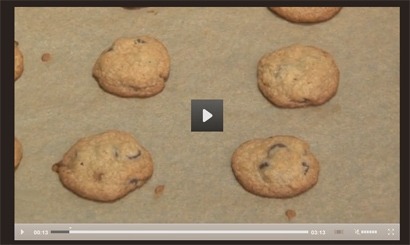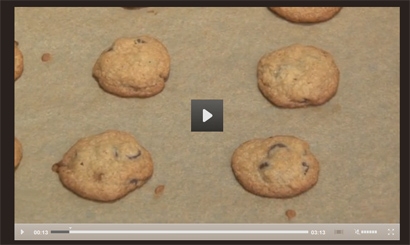How To Make Perfect Cookie Dough
Wiping a cookie dough-covered spoon clean or sticking a finger in the batter when no one's looking are two great perks of making cookies. In fact, one could argue that the dough can be better than the finished product. A friend, who shall remain nameless, used to sneak packages of raw cookie dough into his bed at night as a child, only to have the empty wrappers discovered by his mother the next day... Ah, how far we go for love (and good food).
The chocolate chip cookie is a classic, one that has been done over and over again, nearly to perfection, depending on personal preferences for crispness, chewiness, and thickness. But nailing down the process of making a perfect cookie dough comes with skills and a little know-how. To nail down this technique, we turned to David Crofton of Brooklyn's One Girl Cookies, who also recently authored a cookbook by the same title.
He shares his classic recipe with us, baker's secrets for making cookies, and fun variations for any kind of cookie lover. While the store specializes in "tea-sized cookies" meant to be served with, you got it, tea or coffee, the dough itself can be used to make larger cookies or simply be eaten out of the bowl. [Editor's Note: Consuming raw egg can be dangerous, so proceed with caution.]
Master these basic tips below, and your neighbors will soon be ringing your bell begging for more cookies from the "Cookie People!" (Interject "Lady" or "Man" after "Cookie," if you like.)
Click here to see How to Make the Perfect Chocolate Chip Cookie.
Brown and White Sugar
Crofton uses a mix of light brown and white sugar (1 cup and 1/2 cup, respectively) in his chocolate chip cookie recipe because brown sugar has a molasses flavor that gives a richer flavor and more moistness to the cookies. For crispier cookies, he suggests increasing the amount of white sugar in the recipe and adjusting the ratio accordingly — yes, this will add a little sweetness, but more of a textural change.
Creaming the Butter
"One of the most important parts of making cookies is proper creaming of the butter with the sugar," says Crofton. While he opts to do it by hand in his demo below, he mentions that it can easily be done with a mixer (which will be a lot easier). During the creaming process, the two sticks of butter are absorbing the sugar and Crofton insists that this needs to be done thoroughly, otherwise the cookies will not have the same consistency — "You don't want any chunks of butter or brown sugar because those won't be good to bake."
When it's finished, it will start to look a little lighter in color and texture as the butter absorbs all of the sugar and is thoroughly mixed in.
The secret to a cakier cookie? It's all in the eggs. At least that's what Crofton tells us. He uses two large eggs for his classic chocolate chip recipe, but says to experiment with the number of eggs in a recipe and see what works for you. His main tip is that when adding multiple eggs to a recipe, make sure to add them in gradually because it's always best to add liquid ingredients this way when combining with the butter and sugar. Again, he emphasizes the importance of mixing well so that the batter is uniform. "If you skip this step and start adding in the dry ingredients, then you will end up with streaks of eggs in your batter and that won't be very tasty," he says.
Vanilla Extract
While Crofton uses 1 1/2 teaspoons of a pretty high quality vanilla extract, he says not to sweat it if your grocery store only offers imitation or vanilla flavoring. But if you can find it, it really does make a difference in the final cookie.
Now, only the dry ingredients are left: the flour, baking soda, salt, and of course, chocolate chips — Crofton says you want to add the first three to the batter first. In this last part of the recipe, follow this mantra: Do not overmix the dough. When adding flour in, he says that it's easy to overwork the dough, especially when using a mixer. To prevent this, he adds his chocolate chips to the mixture when the flour is almost done being combined. He just stirs in the chocolate chips (or whatever else you'd like to add — butterscotch, chocolate chunks, mini chips, etc.), until the flour is pretty much absorbed — but no more than that!
For his recipe, he uses 2 1/2 cups all-purpose flour, 1/2 teaspoon baking soda, 1/2 teaspoon salt, and 3 cups semisweet chocolate chips, but check out the variations below if you're looking to experiment.
Everyone loves the classic chocolate chip cookie, but there are so many fun variations that can be done. To name a few, Crofton suggests adding old-fashioned oats to the recipe for texture and flavor, or playing around with other add-ins like dried fruit (cherries, cranberries, raisins), butterscotch chips, or nuts. For nuts, he says to always toast them in the oven until they are brown and fragrant before making the dough. Sprinkling them with a little salt before toasting is another flavor booster. Adding a garnish like poppy seeds to cookies is another way to spruce things up.
Refrigerating Your Dough
If you have the time, Crofton recommends placing the dough in the refrigerator overnight so it comes together nicely. It's an old baker's secret to let the dough sit overnight, as it allows the flavors to meld together. Plus, dough that is really cold and solid will hold its shape a lot better when you bake it, as opposed to room temperature dough that will spread really easily when you bake it.
If you don't have the time, then even just an hour will make a difference. He mentions that freezing the dough is an option, a particularly great one if you have a last-minute guest.
Scooping Onto the Plate
Crofton uses a cookie scoop which is a really easy tool (and low-cost) because it gives you a standard shape and size, but if you don't have it, you can also use two spoons.
For spacing, you want to leave a couple of inches between the cookies at least so you have room for them to grow — the main goal is so that the cookies don't touch each other. One thing to know, he shares, is that the bigger the cookies you make, the more they will spread.
Crofton prefers to bake on parchment paper as opposed to a sprayed cookie sheet because it saves time with cleanup and will make the cookies bake better. You definitely want to use a decent weight pan; it shouldn't be too flimsy so that the heat evenly distributes and you will get a better color and more even bake on the cookies.
For baking, he generally sets the oven to 350 degrees and bakes these chocolate chip cookies for 14-16 minutes. To learn more about the baking process and tips, check out this article on making perfect cookies or some of his recipes below.
Click here to see the Decadent Chocolate Coins recipe pictured at left.
Follow @yasminfahr on Twitter.





